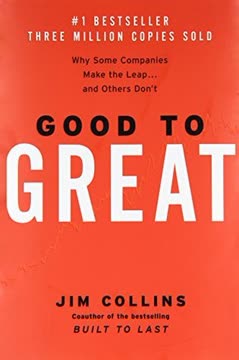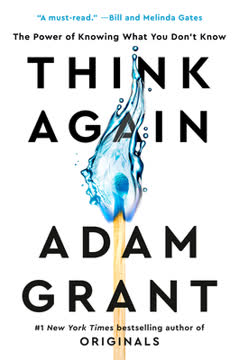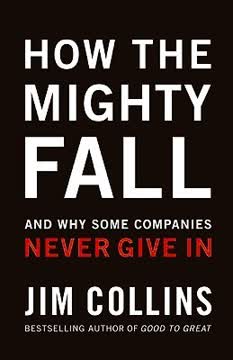Key Takeaways
1. Level 5 Leadership: The Unexpected Foundation of Greatness
Level 5 leaders channel their ego needs away from themselves and into the larger goal of building a great company.
Humble yet determined. Level 5 leaders possess a paradoxical blend of personal humility and professional will. They are ambitious for their companies, not themselves, and attribute success to factors outside themselves while taking personal responsibility for poor results.
Key characteristics:
- Demonstrates a compelling modesty, shunning public adulation
- Acts with quiet, calm determination; relies on inspired standards, not charisma
- Channels ambition into the company, not the self
- Looks in the mirror, not out the window, to apportion responsibility for poor results
These leaders build enduring greatness through a paradoxical combination of personal humility and professional will. They're more like Lincoln and Socrates than Patton or Caesar.
2. First Who, Then What: Getting the Right People on the Bus
The executives who ignited the transformations from good to great did not first figure out where to drive the bus and then get people to take it there. No, they first got the right people on the bus (and the wrong people off the bus) and then figured out where to drive it.
People over strategy. Great companies focus on getting the right people in key positions before determining their strategy. This approach allows for greater flexibility and adaptability as the company evolves.
Key principles:
- If you have the right people, they will be self-motivated
- The right people don't need to be tightly managed or incentivized
- If you have the wrong people, it doesn't matter whether you discover the right direction
This concept emphasizes the importance of building a team of self-disciplined individuals who will perform exceptionally regardless of the specific strategy. It's about creating a culture where the right people thrive and the wrong people don't last.
3. Confront the Brutal Facts: The Stockdale Paradox
You must maintain unwavering faith that you can and will prevail in the end, regardless of the difficulties, AND at the same time have the discipline to confront the most brutal facts of your current reality, whatever they might be.
Balancing optimism and realism. The Stockdale Paradox, named after Admiral James Stockdale, emphasizes the importance of facing reality while maintaining hope. This approach allows companies to make informed decisions without losing sight of their ultimate goals.
Key practices:
- Lead with questions, not answers
- Engage in dialogue and debate, not coercion
- Conduct autopsies without blame
- Build "red flag" mechanisms that turn information into information that cannot be ignored
By embracing this paradox, companies can navigate challenges more effectively, learning from failures without becoming discouraged. This mindset fosters resilience and adaptability in the face of adversity.
4. The Hedgehog Concept: Simplicity in Three Circles
To go from good to great requires transcending the curse of competence.
Finding your sweet spot. The Hedgehog Concept is about understanding the intersection of three crucial elements: what you can be the best in the world at, what drives your economic engine, and what you're deeply passionate about.
The three circles:
- What you can be the best in the world at (and what you cannot be the best at)
- What drives your economic engine
- What you are deeply passionate about
This concept encourages companies to focus on what they can truly excel at, rather than pursuing opportunities outside their core competencies. It's about simplicity and clarity, not complexity and confusion. By understanding and aligning these three elements, companies can achieve sustained success and differentiation in their markets.
5. A Culture of Discipline: Freedom Within a Framework
Sustained great results depend upon building a culture full of self-disciplined people who take disciplined action, fanatically consistent with the three circles.
Disciplined people, thought, and action. A culture of discipline combines a culture of entrepreneurship with an ethic of disciplined behavior. It's not about tyrannical disciplinarians, but about instilling the discipline to stay within the three circles of the Hedgehog Concept.
Key aspects:
- Hire self-disciplined people who don't need to be managed
- Practice disciplined thought to confront brutal facts and develop insight
- Take disciplined action consistent with the Hedgehog Concept
This culture allows for creativity and autonomy within the framework of the company's core focus. It's about giving people freedom and responsibility within clearly defined parameters, fostering innovation while maintaining strategic consistency.
6. Technology Accelerators: Avoiding Fads and Bandwagons
Technology by itself is never a primary, root cause of either greatness or decline.
Strategic application of technology. Good-to-great companies think differently about technology. They avoid jumping on technology bandwagons and instead focus on technologies that directly support their Hedgehog Concept.
Principles for technology use:
- Determine if the technology fits with your Hedgehog Concept
- If yes, become a pioneer in applying that technology
- If no, settle for parity or ignore it entirely
These companies use technology as an accelerator of momentum, not a creator of it. They carefully select technologies that align with their core strategy, avoiding the trap of pursuing technology for technology's sake.
7. The Flywheel Effect: Momentum Trumps Radical Change
Good to great comes about by a cumulative process—step by step, action by action, decision by decision, turn by turn of the flywheel—that adds up to sustained and spectacular results.
Consistent, cumulative progress. The Flywheel Effect illustrates how good-to-great transformations happen through consistent, small wins that build momentum over time, rather than through a single dramatic event.
Stages of the Flywheel:
- Disciplined people
- Disciplined thought
- Disciplined action
- Build-up
- Breakthrough
This concept emphasizes the importance of persistence and consistency in achieving greatness. It's about making a series of good decisions, diligently executed and accumulated one upon another, rather than relying on a single transformative program or innovation.
8. From Good to Great to Built to Last: Sustaining Excellence
Greatness is not a function of circumstance. Greatness, it turns out, is largely a matter of conscious choice.
Enduring greatness. The journey from good to great is just the beginning. To sustain excellence, companies must embed their core values and purpose beyond just making money into their very fabric.
Key elements for sustained greatness:
- Preserve the core ideology
- Stimulate progress
- Align short-term actions with long-term vision
This final concept ties together the ideas from "Good to Great" with those from Collins' earlier work, "Built to Last." It emphasizes that becoming great is a choice, not a circumstance, and that maintaining greatness requires ongoing commitment to core principles while adapting to a changing world.
Last updated:
FAQ
What's Good to Great about?
- Transforming Companies: Good to Great by Jim Collins examines how companies transition from being merely good to achieving sustained greatness.
- Research-Based Insights: The book is based on a five-year research project analyzing companies that made the leap to greatness and sustained it for at least fifteen years.
- Framework for Success: Collins presents a framework including concepts like Level 5 Leadership, the Hedgehog Concept, and a Culture of Discipline.
Why should I read Good to Great?
- Practical Application: The book provides actionable insights applicable to various organizations, not just businesses.
- Timeless Principles: Collins emphasizes that the findings are universally applicable, guiding any organization through change.
- Inspiring Stories: It includes compelling case studies of companies like Walgreens and Kimberly-Clark, illustrating success through disciplined practices.
What are the key takeaways of Good to Great?
- Level 5 Leadership: Great companies are led by leaders who combine personal humility with professional will.
- Hedgehog Concept: Successful companies focus on what they can be the best at, what drives their economic engine, and what they are deeply passionate about.
- Culture of Discipline: A culture fostering self-disciplined people who take disciplined action is crucial for maintaining focus.
What is the Hedgehog Concept in Good to Great?
- Three Intersecting Circles: It is defined by the intersection of what you can be the best at, what drives your economic engine, and what you are deeply passionate about.
- Simplicity and Clarity: The concept emphasizes simplicity in strategy, allowing companies to align decisions with core strengths.
- Example of Walgreens: Walgreens focused on being the best at convenient drugstores, driving their remarkable stock performance.
What is Level 5 Leadership as described in Good to Great?
- Duality of Traits: Level 5 leaders exhibit a blend of personal humility and professional will, prioritizing the company’s success over their own ego.
- Focus on Successors: They prioritize setting up successors for success, ensuring the company’s long-term viability.
- Examples of Leaders: Leaders like Darwin Smith of Kimberly-Clark exemplify Level 5 leadership through selfless dedication.
How do good-to-great companies confront brutal facts?
- Honest Assessment: They maintain a culture where brutal facts are confronted head-on, allowing informed decisions.
- Stockdale Paradox: They retain faith in eventual success while confronting harsh realities, helping navigate challenges.
- Example of Kroger: Kroger’s leadership transformed their business model in response to market changes, leading to success.
What is a Culture of Discipline in Good to Great?
- Self-Disciplined People: It is characterized by self-disciplined individuals taking action aligned with the company’s Hedgehog Concept.
- Freedom Within Framework: Companies foster an environment where employees innovate within a structured framework.
- Contrast with Comparison Companies: Unlike others, good-to-great companies build enduring cultures of discipline beyond individual leaders.
What role does technology play in Good to Great?
- Technology as an Accelerator: Technology is viewed as an accelerator of momentum rather than a creator of it.
- Pioneering Applications: Companies like Walgreens became pioneers in applying technology that supported their core strategies.
- Avoiding Technology Traps: The book warns against relying solely on technology without understanding its fit into the overall strategy.
What is the Flywheel Effect in Good to Great?
- Cumulative Momentum: It describes building momentum through consistent, disciplined actions over time.
- No Single Defining Moment: Transformations result from many small pushes, not a single breakthrough.
- Sustained Results: Companies experience sustained performance improvements, creating a self-reinforcing cycle of growth.
What is the Doom Loop in Good to Great?
- Cycle of Inconsistency: It describes companies that fail to achieve sustained greatness by lurching from one initiative to another.
- Misguided Strategies: These companies attempt breakthroughs through large acquisitions rather than incremental improvements.
- Failure to Learn: They often fail to confront brutal facts, leading to a lack of accountability and adaptability.
What are the best quotes from Good to Great and what do they mean?
- “Good is the enemy of great.”: Settling for good prevents organizations from achieving greatness, urging continuous improvement.
- “You must retain faith...”: Balancing optimism with realism is key, as highlighted by the Stockdale Paradox.
- “The right people will do the right things...”: Emphasizes the importance of having the right people aligned with company values.
How can I apply the concepts from Good to Great to my organization?
- Identify Your Hedgehog Concept: Understand what your organization can be the best at, what drives your economic engine, and what you are passionate about.
- Foster Level 5 Leadership: Encourage leaders to embody Level 5 traits, focusing on humility and long-term success.
- Create a Culture of Discipline: Build a disciplined culture where self-motivated individuals take action aligned with organizational goals.
Review Summary
Good to Great receives mixed reviews. Many praise its research methodology and insights on leadership, discipline, and focusing on core strengths. Readers find the concepts applicable beyond business. Critics argue the principles are common sense, the sample size is too small, and some featured companies later struggled. The book's dated examples and catch phrases irritate some. Overall, it's considered a influential business book, though opinions vary on its lasting relevance and scientific validity.
Similar Books
Download PDF
Download EPUB
.epub digital book format is ideal for reading ebooks on phones, tablets, and e-readers.




















